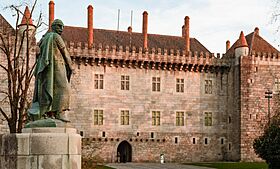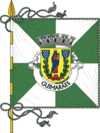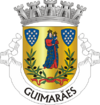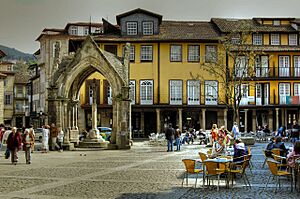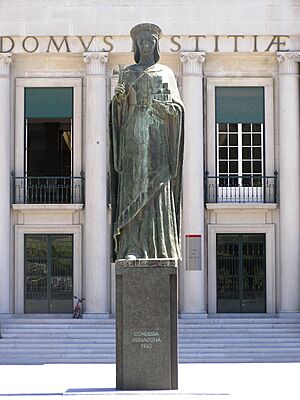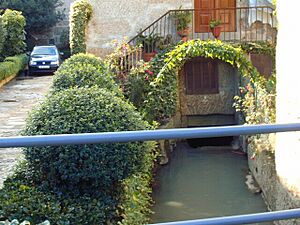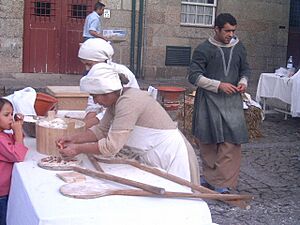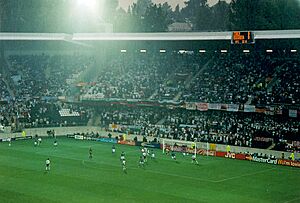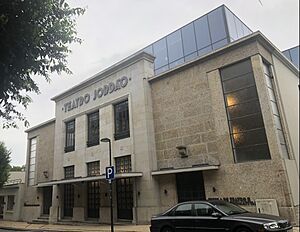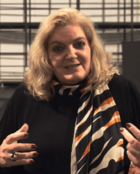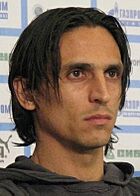Guimarães facts for kids
Quick facts for kids
Guimarães
|
|||
|---|---|---|---|
|
Municipality
|
|||
|
Top: Palace of the Dukes of Braganza; middle: Santos Passos Church; Castle of Guimarães; Historic Centre of Guimarães; bottom: Toural Square; Oliveira Square.
|
|||
|
|||
 |
|||
| Country | |||
| Region | Norte | ||
| Intermunic. comm. | Ave | ||
| District | Braga | ||
| Parishes | 48 | ||
| Area | |||
| • Total | 241.3 km2 (93.2 sq mi) | ||
| Population
(2021)
|
|||
| • Total | 156,830 | ||
| • Density | 649.94/km2 (1,683.3/sq mi) | ||
| Time zone | WET/WEST (UTC+0/+1) | ||
| UNESCO World Heritage Site | |
|---|---|

The Palace of the Dukes of Braganza (From IPPAR)
|
|
| Criteria | Cultural: (ii), (iii), (iv) |
| Inscription | 2001 (25th Session) |
| Area | 19.45 ha (48.1 acres) |
| Buffer zone | 99.23 ha (245.2 acres) |
Guimarães is a city and municipality in northern Portugal. It is located in the Braga District.
Its old town centre became a UNESCO World Heritage Site in 2001. This was because it is a very well-preserved example of how a medieval town grew into a modern city in Europe. The city's main celebrations are called the Nicolinas.
Guimarães is known as the capital of the Ave Subregion. This area is one of the most industrial parts of Portugal. The city is in the historic Minho Province. In 2021, about 156,830 people lived in the municipality, which covers an area of 240.95 square kilometers. The current mayor is Domingos Bragança from the Socialist Party. In 2012, Guimarães was the European Capital of Culture, sharing the title with Maribor, Slovenia.
The city was first settled in the 9th century and was called Vimaranes. This name might have come from a warrior named Vímara Peres. He chose this area as the main place to govern the County of Portugal, which he had conquered. Guimarães is very important in Portugal's history because it played a big role in the country's creation. People often call it the "birthplace of Portugal" or "the cradle city" (Cidade Berço in Portuguese). This is because Portugal's first King, Afonso Henriques, was born here. Also, the Battle of São Mamede, which helped create the Kingdom of Portugal, happened near the city. In 2022, Condé Nast Traveler magazine named Guimarães the most beautiful small city in Europe.
Contents
History of Guimarães: Portugal's Birthplace
The history of Guimarães is closely linked to how Portugal became a country. Guimarães existed even before Portugal was officially founded. Because of its important role, it is known as the "cradle of Portuguese nationality." In 1128, major political and military events happened here that led to Portugal's independence. That's why an old tower in the city wall has the words "Aqui nasceu Portugal" (Portugal was born here).
Early Settlements and Roman Times
Archaeological finds show that people have lived in the Guimarães area since the late Chalcolithic period (Copper Age). There is also proof that the Romans lived here. A stone found in Caldas das Taipas suggests it was a spa town even in Roman times.
How Guimarães Was Founded
The city's medieval beginnings date back to the 10th century. This was during the Reconquista, a time when Christian kingdoms were taking back land from Muslim rule. Countess Mumadona Dias built a monastery on her land in Vimaranes. This led people to settle in the area known as "vila baixa" (downtown). At the same time, she ordered a castle to be built on a nearby hill, which became "vila alta" (uptown). The Rua de Santa Maria was built to connect these areas.
The monastery became very important over time. It received gifts from nobles and kings and became a famous place for pilgrims. Henry, Count of Portugal likely approved the first national foral (a set of laws or a charter for a town) around 1096. This showed how important Guimarães was becoming as the capital of the County of Portugal. On June 24, 1128, the "Batalha de São Mamede" (Battle of São Mamede) took place in Guimarães. This battle was a key moment in Portugal's history.
Growth in the Middle Ages
As Guimarães grew, King Denis had a defensive wall built around part of the town. Later, during the rule of John I, this wall was taken down. The two parts of the city (uptown and downtown) then joined together. The city began to expand beyond its old walls.
Modern Changes and Development
Until the 19th century, the city's structure didn't change much. A few more churches, convents, and palaces were built. But by the late 1800s, new ideas about city planning brought big changes. Queen Maria II officially made Guimarães a city on June 23, 1853. The city walls were completely removed, and new streets and avenues were created. This careful planning helped keep the city's beautiful historic center. In 2024, Guimarães hosted the 2024 European Trampoline Championships.
Geography of Guimarães
Guimarães is located in a valley surrounded by hills.
Land and Rivers
Most of the municipality has granite rock formations. You can also find schist rocks in some areas to the northwest. In the southeast, there is clay near the Ave river, Vizela, and Selho rivers.
The municipality is bordered by hills. To the north is "Senhora do Monte." To the northwest are the hills of Falperra, Sameiro, Outeiro, and Penedice. To the south is Penha hill, which is the highest point at 613 meters.
Guimarães is part of the drainage basin of the Ave river, which flows through the middle of the municipality. The Ave river has smaller rivers flowing into it, such as the Vizela, Torto, and Febras. Inside the city, the Selho, the Couros, and the Santa Lúzia stream also flow.
Climate and Wildlife
Because Guimarães is in a valley and far from the sea, its winters are usually cold and rainy. Summers are hot and a little humid. The average temperature each year is about 14°C.
The city's wildlife isn't very diverse, especially in urban areas. However, some animals that are hunted can be found, like the red fox, wild boar, turtle dove, thrush, pigeon, and red-legged partridge. In the green areas of the city, you'll most often see rodents, especially squirrels.
Local Divisions: Parishes
Administratively, the municipality of Guimarães is divided into 48 civil parishes (called freguesias). There used to be 69, but some were combined in 2013 as part of a country-wide change.
Population Changes Over Time
The population of Guimarães has changed a lot over the years. Here are charts showing how the number of people living in the municipality and the city center has grown and shrunk.
- Evolution of the population of the municipality of Guimarães (1801–2021)
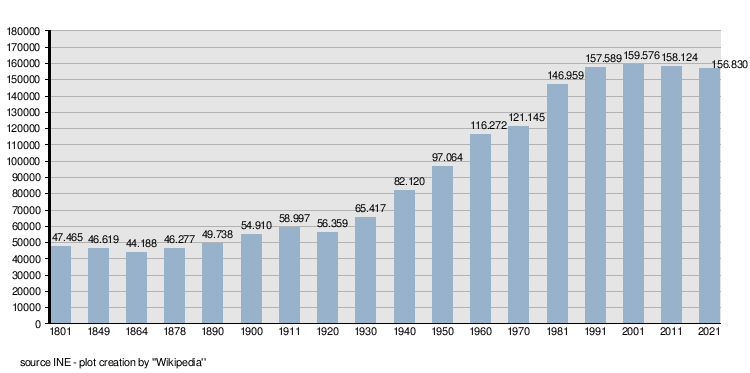
- Evolution of the population in the city centre (1864–2011)
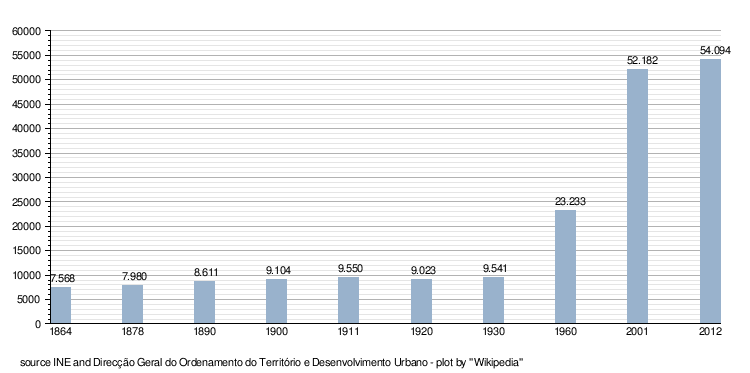
Culture and Fun in Guimarães
Guimarães is a medium-sized city with a lively cultural scene. It has many museums, monuments, cultural groups, art galleries, and popular festivals. Since 2005, the Vila Flor Cultural Center has been an important cultural spot. It has two auditoriums, an exhibition center, and a concert-cafe. Guimarães was the European Capital of Culture in 2012, along with Maribor in Slovenia.
Guimarães is also home to the Vitória S.C. football club. They play in the Primeira Liga, which is the top football league in Portugal. The New York Times chose Guimarães as one of the 41 best places to visit in 2011. They called it one of the Iberian Peninsula's rising cultural spots.
Local Food and Treats
The fact that Guimarães was founded on land owned by a convent (a place where nuns live) greatly influenced its food. This is especially true for its sweets. Some famous treats include "Tortas de Guimarães" (Guimarães' tarts), which are flaky pastries. Another is "Toucinho do céu" (often called "bacon from heaven"), a moist, yellow pudding-cake.
Besides these, you can find typical foods from the Minho Province. These include "vinho verde" (green wine), "Papas de sarrabulho" (a pork and blood porridge), and "Rojões" (stewed pork with potatoes and sausage). Also popular is "Bôla de carne" (Meat cakes). This is a type of bread, shaped like a pizza, served with bacon, sardines, or other toppings.
Fun Traditions and Festivals
- Festas Gualterianas (Gualteriana festival): This festival honors São Gualter (Saint Walter). It has been held since 1906 during the first weekend of August. The "Cortejo do Linho" (Linen parade) and the "Batalha das Flores" (Battle of the Flowers) are part of the fun. The festival ends with the "Marcha Gualteriana" (Gualteriana march).
- Nicolinas: These are the student festivals of Guimarães, celebrated for Saint Nicholas. They begin on November 29th and end on December 7th. They include different events. The "Pinheiro" celebration is the most popular. After the "Ceia Nicolina" (Nicolinas supper), students parade through the streets. They play the "Toques Nicolinos" tune on drums. Traditionally, a pine tree (o Pinheiro) is pulled in carts by bulls. People have suggested that the "Nicolinas" should become a UNESCO intangible cultural heritage.
- Santa Luzia festivities: These celebrations honor Saint Lucy and happen every year on December 13th. They take place near the Santa Luzia chapel. A tradition is selling special cakes made of rye flour and sugar, called "Sardão" and "Passarinha." The tradition says a boy should give a "Sardão" to a girl. If the girl likes him, she should give him a "Passarinha" back.
- Romaria Grande de São Torcato (São Torcato Big pilgrimage): This is one of the biggest pilgrimages in Minho. It happens every July in the village of São Torcato.
Museums and Art Spaces
Guimarães has several important cultural places. The Alberto Sampaio museum is one of the most notable. It opened in 1931 and is located where the old Collegiate of Our Lady of Oliveira used to be. It has a rich collection of items from the 14th, 15th, and 16th centuries. This includes a rare vest worn by King John I.
The Martins Sarmento Society is one of Portugal's oldest groups dedicated to studying and protecting old artifacts. The society has two museums. The Archaeological Museum of the Martins Sarmento Society is known for its collections from prehistory and early history. It also has coin and inscription collections. The Castro Culture Museum focuses on the Castro culture.
Other museums include:
- The Primitive Modern Arts Museum, which has a collection of naïve art.
- The Museum of the Village of São Torcato, about the region and its connection to the monastery and Saint Torcato.
- The Agriculture Museum of Fermentões, showing traditional farming tools and practices.
- The Museum of São Sebastião, opened in 1984, mainly displaying sacred art.
Other cultural places are:
- Vila Flor Cultural Center: This is the main cultural venue in Guimarães. It was built in 2005 next to the restored Vila Flor Palace. It has two auditoriums, a concert-cafe, and an exhibition gallery. The palace gardens were also redone and won an award in 2006.
- São Mamede – Guimarães Arts and Shows Center.
- Raul Brandão Municipal Library: The main library is in the city, with branches in other towns. It also has a mobile library that visits 42 parishes, schools, and the local prison.
- The Art Laboratory: Started in 2004 by students, it's a space for art shows, performances, music, and workshops.
- Alfredo Pimenta National Archive: Founded in 1931, it holds historical records for Guimarães and the Braga district.
Sports in Guimarães
Guimarães has two main sports clubs. Vitória Sport Clube's football team plays in the Primeira Liga, Portugal's top football league. They have won a Portuguese Cup in 2012/13 and a Portuguese Supercup in 1988. Moreirense Futebol Clube's football team also plays in the Primeira Liga. They have won the Portuguese Second Division in 2013/14 and the Portuguese League Cup in 2016/17.
Vitória SC also has teams for basketball, volleyball, and water polo. These teams compete in the top divisions of their sports.
Life in Guimarães
In 2008, Guimarães was ranked the second most livable city in Portugal. It is also the 10th least polluted city in the country, according to IQAir.
In 2004, 89% of the people had running water. By 2006, this was expected to rise to 95%. In 2001, 63.5% of the population had basic sanitation (sewage systems). This was expected to reach 80% by 2008. In 2001, all residents had access to waste management services.
Some people feel that the city, like others in the Braga district, has grown in a way that is not always pretty or organized.
Local News and Media
Guimarães is fourth in the country for the number of newspapers available. The oldest was "Azemel Vimaranense," started in 1822. It might have stopped publishing because of political events. From 1856, other newspapers appeared, like "A Tesoura de Guimarães." Today, the city's newspapers include:
- O Comércio de Guimarães
- O Cónego
- O Conquistador
- Desportivo de Guimarães
- Entrevillas
- O Expresso do Ave
- Jornal do Adepto
- Lordelo Jornal
- Notícias de Guimarães
- O Pilar
- O Povo de Guimarães
- Reflexo – O Espelho das Taipas
- Sport Jornal dos Desportos
Radio Stations
There are two radio stations based in Guimarães: Radio Fundação (95.8 FM) and Radio Santiago (98.0 FM).
Television Channels
Guimarães TV started broadcasting online on July 24, 2007. It is a project between the city's assembly and the Guimarães Cybercenter. Its shows are also featured on the Região Norte TV channel, available through cable.
"Canalguimarães" was another online channel that began in March 2010. It was created by an arts group called "Associação de Socorros Mútuos Artística Vimaranense," one of the city's oldest associations.
Economy and Transport
Guimarães is one of the most industrial municipalities in Portugal. Its main industries are textiles (making clothes and fabrics), shoe manufacturing, and metalomechanics (working with metals).
Getting Around: Transport
Guimarães is connected to Porto by the Guimarães line railway. This train line was updated and rebuilt in the early 2000s. The train service is run by Comboios de Portugal (CP). Within Guimarães, TUG (Transportes Urbanos de Guimarães) operates 21 bus routes that serve the city.
Cities Guimarães is Connected To
Guimarães has sister city relationships with several cities around the world. This means they share cultural and educational ties.
 Brive-la-Gaillarde, France
Brive-la-Gaillarde, France Colonia del Sacramento, Uruguay
Colonia del Sacramento, Uruguay Compiègne, France
Compiègne, France Dijon, France
Dijon, France Igualada, Spain
Igualada, Spain Kaiserslautern, Germany
Kaiserslautern, Germany Ponte de Lima, Portugal
Ponte de Lima, Portugal Londrina, Brazil
Londrina, Brazil Mé-Zóchi, São Tomé and Príncipe
Mé-Zóchi, São Tomé and Príncipe Montluçon, France
Montluçon, France Ribeira Grande de Santiago, Cape Verde
Ribeira Grande de Santiago, Cape Verde Rio de Janeiro, Brazil
Rio de Janeiro, Brazil Tacoronte, Spain
Tacoronte, Spain
Famous People from Guimarães
Many notable people have come from Guimarães.
Historical Figures
- Urraca Henriques (c. 1095-1173): A noblewoman, daughter of Teresa de Leão and sister of Afonso I.
- Afonso I of Portugal (1111–1185): Known as "the Conqueror," he was the first King of Portugal.
- Paio Galvão (c. 1165–1230): A Cardinal and leader of the Fifth Crusade.
- Blanche of Portugal (1259–1321): An infanta (princess), the first child of King Afonso III of Portugal.
- Gil Vicente (c. 1465–ca.1536): A famous playwright and poet who also acted and directed his own plays.
- Agostinho Barbosa (1589–1649): A writer on church law who became a Bishop in Italy.
- Catarina de Lencastre, Viscountess of Balsemão (1749—1824): A noblewoman, poet, and playwright.
Modern Personalities
- António Augusto da Silva Cardoso (1831-1893): A Portuguese painter.
- Alberto Sampaio (1841-1908): A historian, writer, archaeologist, and teacher.
- Vicente Pinheiro Lobo Machado de Melo e Almada (1852-1922): A politician, diplomat, and colonial administrator.
- João Gomes de Oliveira Guimarães (1853-1912): A politician, historian, and Catholic priest.
- Abel Cardoso (1877-1964): A painter, and son of António Augusto da Silva Cardoso.
- Alfredo Pimenta (1882–1950): A historian, poet, and writer about the Middle Ages.
- Abel Salazar (1889–1946): A physician, lecturer, researcher, writer, and painter.
- Emídio Guerreiro (1899-2005): A teacher, politician, and opponent of the Estado Novo government.
- Arnaldo Sampaio (1908-1984): A doctor who received the Grã-Cruz da Ordem do Mérito medal.
- Duarte Freitas do Amaral (1909–1979): A Portuguese politician and deputy in the National Assembly of Portugal.
- Mário António Caldas de Melo Saraiva (1910-1998): A historian, doctor, politician, and writer.
- Alberto Martins (born 1945): A lawyer, politician, and congressperson.
- Luís Marques Mendes (born 1957): A Portuguese lawyer and politician.
- Elisabete Matos (born 1964): A Portuguese soprano singer.
- Pedro Chagas Freitas (born 1979): A writer, journalist, and public speaker.
- Marisa Ferreira (born 1983): An artist known for her public art and geometric art.
- Sofia Escobar (born 1984): A soprano singer and actress in London's West End musicals.
- Renato Freitas (born 1991): An electronic music artist known by his stage name Lizzy's Husband.
Sports Stars
- Francisco "Xico" Ferreira (1919–1986): A footballer with many club games and 25 games for Portugal.
- Aurora Cunha (born 1959): A former athlete.
- Horácio Gonçalves (born 1962): A retired footballer and now a manager.
- Domingos Castro (born 1963): A former long-distance runner who competed in four Summer Olympics.
- Dionísio Castro (born 1963): A former long-distance runner who competed in two Summer Olympics.
- Miguel Marques (born 1963): A retired footballer with over 500 club games.
- Quim Berto (born 1971): A former professional footballer with many club games.
- Fernando Meira (born 1978): A footballer with over 500 club games and 54 games for Portugal.
- Pedro Mendes (born 1979): A footballer with many club games and 11 games for Portugal.
- Domingos Alexandre Martins Costa (born 1979): Known as Alex, a former footballer with many club games.
- Rui Faria (born 1980): Known as Faria, a football goalkeeper with many club games.
- Ricardo (born 1980): A Cape Verdean footballer with many club games and 16 games for Cape Verde.
- Vítor Lima (born 1981): A retired footballer with many club games.
- Carlos Carneiro (born 1982): A former Portuguese handball player.
- Ana Dulce Félix (born 1982): A long-distance runner who competed in two Summer Olympics.
- Custódio Castro (born 1983): Known as Custódio, a retired footballer with many club games and 10 games for Portugal.
- Vieirinha (born 1986): A footballer with over 400 club games and 25 games for Portugal.
- Márcio Sousa (born 1986): A professional footballer with over 350 club games.
- João Sousa (born 1989): Portugal's top tennis player, ranked 36th by the ATP.
- Rui Bragança (born 1991): A Portuguese taekwondo athlete.
See also
 In Spanish: Guimarães para niños
In Spanish: Guimarães para niños


